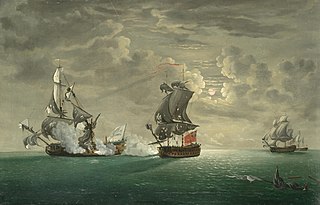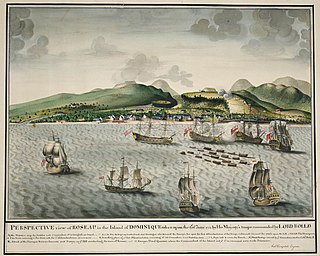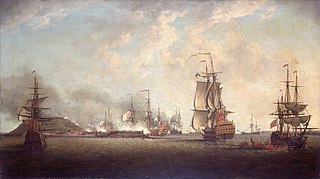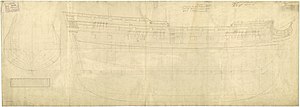
HMS Bellona was a 74-gun Bellona-class third-rate ship of the line of the Royal Navy. Designed by Sir Thomas Slade, she was a prototype for the iconic 74-gun ships of the latter part of the 18th century. "The design of the Bellona class was never repeated precisely, but Slade experimented slightly with the lines, and the Arrogant, Ramillies, Egmont, and Elizabeth classes were almost identical in size, layout, and structure, and had only slight variations in the shape of the underwater hull. The Culloden-class ship of the line was also similar, but slightly larger. Thus over forty ships were near-sisters of the Bellona." Bellona was built at Chatham, starting on 10 May 1758, launched on 19 February 1760, and commissioned three days later. She was the second ship of the Royal Navy to bear the name, and saw service in the Seven Years' War, American Revolutionary War and the Napoleonic Wars.
HMS Antelope was a 50-gun fourth rate ship of the line of the Royal Navy, launched at Rotherhithe on 13 March 1703. She was rebuilt once during her career, and served in the Seven Years' War and the American Revolutionary War.
HMS Norfolk was a 74-gun third-rate ship of the line of the Royal Navy, and the second ship to bear the name. She was built by Adrian Hayes at Deptford Dockyard and launched on 8 December 1757. She was active during the Seven Years' War.

HMS Monmouth was a 66-gun third-rate ship of the line of the Royal Navy, and was likely named for James, Duke of Monmouth. She served from 1667 to 1767, winning ten battle honours over a century of active service. She was rebuilt a total of three times during her career—each time effectively becoming a completely new ship.

HMS Lichfield was a 50-gun fourth rate ship of the line of the Royal Navy, built at King's Yard in Harwich by John Barnard to the dimensions laid down in the 1741 proposals of the 1719 Establishment, and launched on 26 June 1746. She was wrecked on the Barbary Coast of North Africa on 28 November 1758.

HMS Dublin was a 74-gun third rate ship of the line of the Royal Navy, built by Adam Hayes at Deptford Dockyard and launched on 6 May 1757.

HMS Duke was a 90-gun second-rate ship of the line of the Royal Navy, launched on 13 June 1682 at Woolwich Dockyard.

HMS Prince was a 100-gun first rate ship of the line of the Royal Navy, built by Phineas Pett the Younger at Deptford Dockyard and launched in 1670.

HMS Royal Sovereign was a 100-gun first rate ship of the line of the Royal Navy, built at Woolwich Dockyard and launched in July 1701. She had been built using some of the salvageable timbers from the previous Royal Sovereign, which had been destroyed by fire in 1697.
Duc d'Aquitaine was a 64-gun East Indiaman of the Compagnie des Indes, launched in 1754. On 30 May 1757, she was captured by the Royal Navy and commissioned as the third rate HMS Duc D'Aquitaine. She foundered in 1761 and was lost.

President was a 38-gun fourth rate frigate of the Royal Navy, originally built for the navy of the Commonwealth of England by Peter Pett I at Deptford Dockyard, and launched in 1650.
HMS Greenwich was a 50-gun fourth rate ship of the line of the Royal Navy. She was built during the War of the Austrian Succession, and went on to see action in the Seven Years' War, during which she was captured by the French and taken into their service under the same name. She was wrecked shortly afterwards.

HMS Essex was a 70-gun third rate built by Sir Henry Johnson of Blackwall in 1678/79. During the War of the English Succession she fought in the last major action. She was rebuilt in 1699/1700. During the War of Spanish Succession she fought at Vigo Bay, the Capture of Gibraltar and Velez Malaga. She also fought at the Battle off Passero in 1718. She was rebuilt again in 1736-40. She was in action off Toulon in 1744. She was active in the Channel and against French ports during the Seven Years War. She fought at Quiberon Bay in 1759. She was wrecked in Quiberon Bay in November 1759.

HMS Swiftsure was a 70-gun third-rate ship of the line of the Royal Navy, launched in 1755 and in active service during the Seven Years' War. After a distinguished career at sea she was decommissioned in 1763 and sold into private hands ten years later.

HMS Nassau was a 70-gun third rate ship of the line of the Royal Navy, built at Portsmouth Dockyard and launched on 9 January 1706.

HMS Augusta was a 60-gun fourth-rate ship of the line of the Royal Navy, built to the 1733 proposals of the 1719 Establishment at Deptford Dockyard, and launched on 1 July 1736.

HMS Defiance was a 58-gun fourth rate ship of the line of the Royal Navy, built to the dimensions laid out in the 1741 proposals of the 1719 Establishment at Deptford, and launched on 12 October 1744.

HMS Eagle was a 58-gun fourth rate ship of the line of the Royal Navy built at King's Yard in Harwich by John Barnard and launched in 1745.
HMS Pembroke was a 60-gun fourth rate ship of the line of the Royal Navy, built by Thomas Bucknall at Plymouth Dockyard to the draught specified in the 1745 Establishment as amended in 1752, and launched on 2 June 1757.
HMS Burford was a 70-gun third rate ship of the line of the Royal Navy, built at Chatham Dockyard to the draught specified by the 1745 Establishment as amended in 1754, and launched in 1757.














